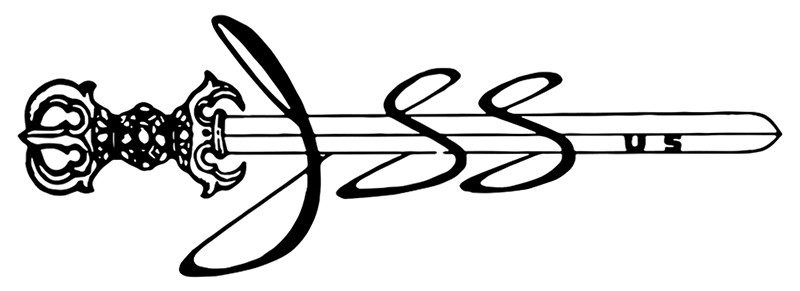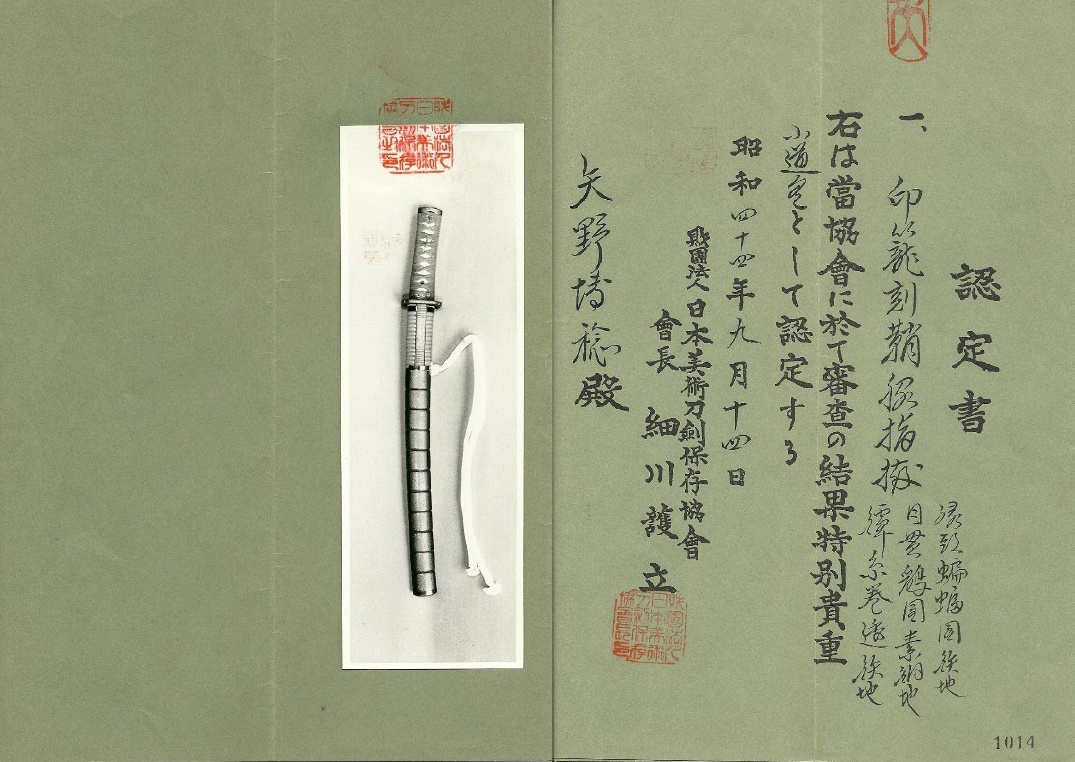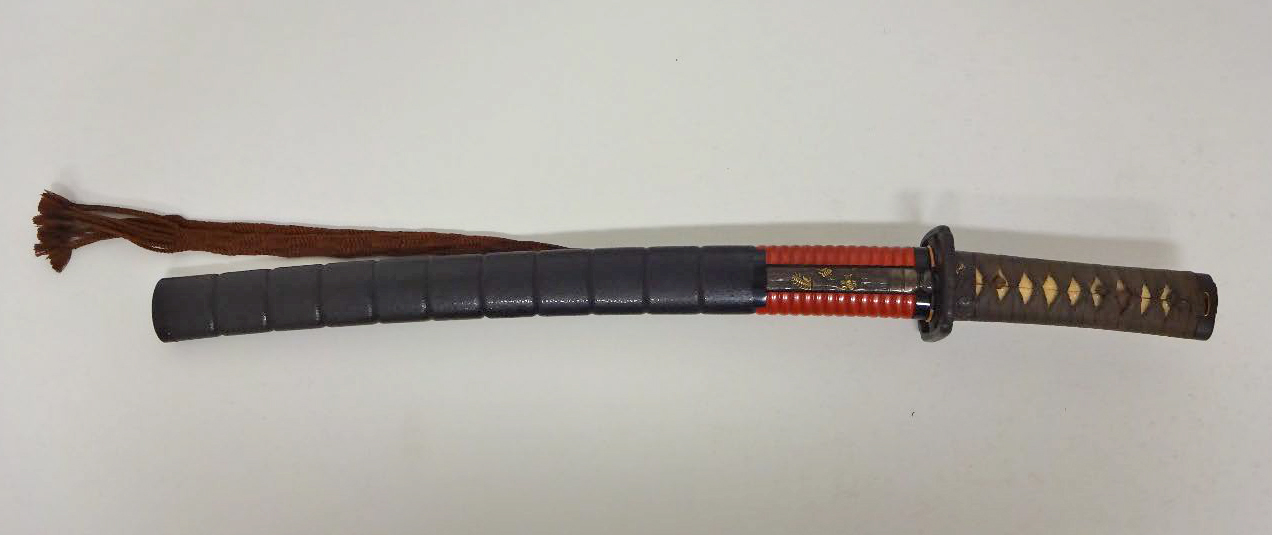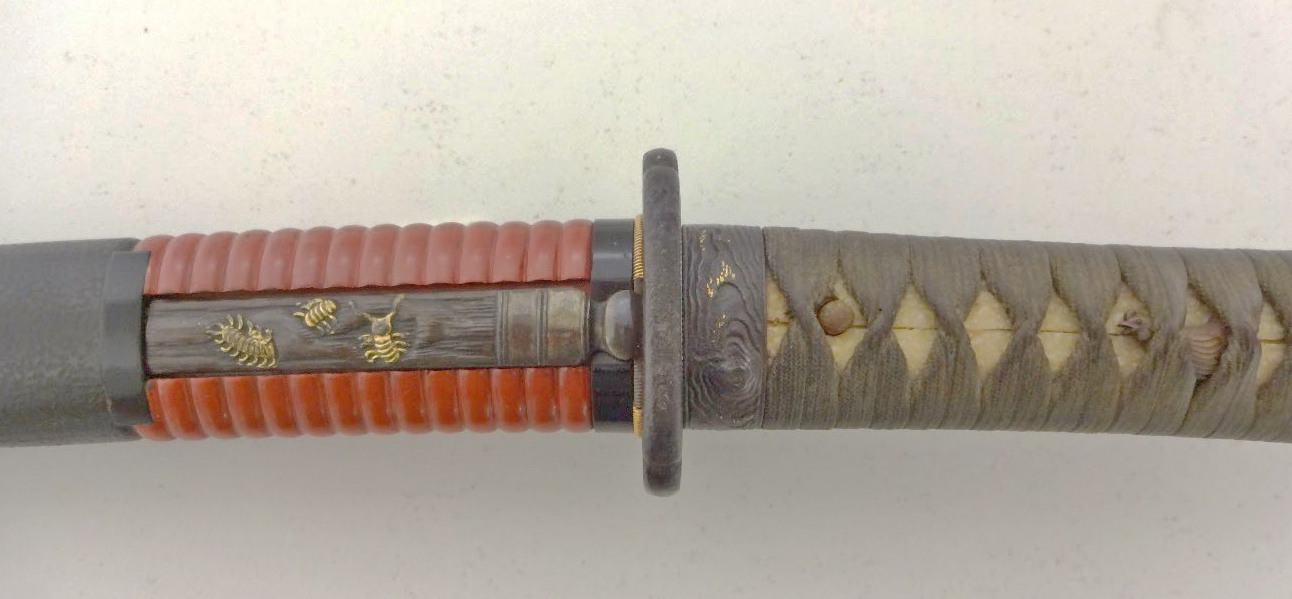
Swords that we like: 2) Hida (no) kami Ujifusa by W. Brent Tanner and F. A. B Coutinho
Swords that we like: 2) Hida (no) kami Ujifusa
W. Brent Tanner and F. A. B Coutinho
Introduction
In this article we review a Wakizashi by Hida (no) kami Ujifusa and the koshirae of the sword.
Section 2 introduces what is referred to as the Owari Shinto School of which Hida (no) Kami Ujifusa was considered its best swordsmith. We reference research material provided from an article by Tanobe Michihiro (Tanobe(1986)) to describe in general terms the characteristics of his work.
Section 3 provides a technical description of the sword (sugata, dimensions, kitae , hamon and nakago), gives an artistic appreciation of the sword and compares the workmanship of this example against a general description of his works.
Section 4 discusses the sword koshirae. As we have seen in previous articles (“Real life kantei of Swords #16: About the position of the mekugi ana in the nakago”), swords were often shortened to accommodate different koshirae. We believe this sword is an extreme example of such shortening.
A brief introduction to the Owari Shinto school and the swordsmith Hida (no) kami Ujifusa (飛騨守氏房)
The Sengoku period (戦国時代) from 1467 to 1615, also known as the "Age of Warring States", was a period in Japanese history of continual civil war, social upheaval, and political intrigue. At the end of this period the province of Owari was governed by Oda Nobunaga( 織田信長 ) who became the dominant diamyo over the other war lords in a power struggle for unification of Japan and restoration of a central government. After entering Kyoto, Nobunaga was given several court appointed titles by the Emperor. These titles included Major Counselor (Gondainagon), Ukon'etaishō, and Minister of the Right (Udaijin). In 1578 the court made him the Grand Minister of State (Daijo daijin), the highest post that could be given by the Emperor.
During this time many swordsmiths moved from Mino to Owari and founded the Owari School which enjoyed great prosperity in the ensuing Shinto period. Notable swordsmiths included Sagami (no) kami Masatsune , Hoki (no) kami Nobutaka and Hida (no) kami Ujifusa. These are considered the most representative swordsmiths for this school.
Hida (no) Kami Ujifusa was born in the 10th year of Eiroku (1567). His father Wakasa-no-kami Ujifusa (若狭守氏房) was hired by Oda Nobunaga to work exclusively for him. In the 5th year of Tensho (1577), Hida (no) kami Ujifusa 飛騨守氏房 moved to the Azuchi castle town in Ōmi Province along with his father Wakasa-no-kami Ujifusa若狭守氏房. There he began to work exclusively as a page of Oda Nobutaka 織田信孝 who was the third son of Oda Nobunaga. After the Nagoya castle restoration in 1610, he moved from Kiyosu to Kaji town, Nagoya (now in 3 chome Marunouchi,Naka-ku) and then retired in 1631. He yielded his position as head of the Ujifusa clan to his eldest son the third generation Bizen-no-kami Ujifusa 備前守氏房. Hida-no-kami Ujifusa 飛騨守氏房 passed away in that same year at the age of 65 years old. The extant works of Hida (no) Kami Ujifusa are comprised of katana, shinogi-zukuri wakizashi, hira zukuri wakizahi and tanto. Yari and naginata are rare. His kissaki are either a slightly extended medium or large size. His sori is generally slight. Most of his mune are iori but there are some mitsu exceptions. His wakizashi in hira-zukuri form, are wide and largely in sunnobi size with saki sori. His tanto are either long with modest sori and rarely considerably small with uchi sori.
The kitae is either itame with a coarse grain formation containing straight grained areas or tight itame with a whitish color. His hamon is generally wide and forms squarish notare, mixed with a variation of a pointed form of gunome. Some examples are in o-notare containing ashi, others have typical gunome-choji paterns.
His nioiguchi is cloudy and unclear with the ha-buchi admirably covered with sometimes very coarse grains (ara-nie) placed irregularly. The grain activities in the ha are subdued and inconspicuous.
The boshi takes different forms: midare-komi and a pointed tip resembling a mishina boshi, or ko-maru. Very rarely ichimai without kaeri is utilized. Most of his boshi have a long kaeri.
The nakago tip is kurijiri shaped and has sujikai yasurime.Technical description of the subject sword
Sugata
Wakizashi in hira zukuri Nagasa : 40.2 cm
Moto haba: 3.3 Cm
Sori: 0.5 cm
Kitae:
Well grained ko-itame with profuse ji nie and some ara nie. There is no visible utsuri.
Hamon:
Large notare with small gunome midare made of dense nie
Jidai:
Keicho era (1596)
Nakago:
The nakago is suriage to accommodate the Koshirae. Two meguki-ana are present.
Authentication papers and photos:

Figure 1- Tokubetsu Kicho certificate by the NBTHK issued 1967, September 9th.

Figure 2 – Certificate by Shibata Sensei dated 2004, June 9th.

Figure 3- Pictures of the sword and an oshigata

Figure 4- Picture of the suriage nakago. One can note that is in a very nice condition and was perhaps shortened to fit the koshirae
Artistic appreciation
The blade is a medium length and thick hira zukuri wakizashi which is very typical of the Keisho era. One can assume that it was originally used in battle. The battles during this period (fought between Oda Nobunaga, Takeda Shigen, Tokugawa Ieyasu and many other commanders) were close quarters infantry battles. The shape of this sword and of many others we have seen (some longer and heavier than this one) would be very appropriate for this kind of combat. This shape is sometimes referred enthusiastically in the literature as “magnificent heroic”. Even though the blade is in an old polish, the apparent quality, both artistic and as a weapon is better than average. The width and thickness ensure durability and the consistency and pattern of the hamon would ensure sharpness. The flowing notare with the dense gumone style nie structures add a sense of calmness and visual interest to the blade. There is even some activity within the hamon that can be found by the observant admirer. All of this leads to a practical yet aesthetically pleasing weapon of war. Although the blade lacks the elegance and magnificence of a katana, it is still a blade worthy of preserving and admiring. Being crafted by one of the premier swordsmiths of the Owari Shinto School adds further to it value and collectability.
The nakago as shown in Figure 4 was probably shortened to fit the very elegan koshirae described below. The nakago is in a nice state of preservation and so is the lacquer attribution. This would lend credibility to our guess that the sword was shortened to fit the koshirae. We believe the original mekugi-ana is the one in the bottom. (W. B. Tanner (2019). On the sachi ura side, the characters Uji Fusa are painted in red lacquer, most likely by the person who shortened the sword to fit the koshirae.
Koshirae (The mounting of the sword)

Figure 5 - The certificate of the koshirae. The certificate is an old Tokubetsu kicho (dated Showa 44 (1966), September 14th) and nowadays it would perhaps correspond to Tokubetsu Hozon


Figure 6- A color photograph of the en-suite koshirae of Hida no kami Ujifusa.
The koshirae is very elegant and appears to have been made during the Edo era. Considering it is en-suite and has quality hardware, it was probably used by a rich merchant. However, it is not the only koshirae made for this sword, because there are two mekugi-ana. We would speculate that this is the second koshirae for this sword, since the current koshirae is utilizing the second meguki-ana. The fact that the sword was shortened to accommodate the koshirae suggests that the person who commissioned these fittings considered this koshirae elegant enough to have the sword shortened.
The fittings are comprised of an Owari iron sukashi tsuba, shibuchi menuki representing a domestic chicken, iron fuchi kashira portraying a bat and weathered wood with a cavern. There is a matching shibuchi kozuka continuing the weathered wood theme with invasive insects.
The saya is inro style with red and black urushi (Japanese lacquer) in ishimeji pattern. The style of saya is referred to in Japanese as inro kizami saya.
References
Tanobe (Spring 1986) Tanobe Michihiro , Hida-no- Kami Ujifusa, Token Bijutsu 28, pages 30- 31.